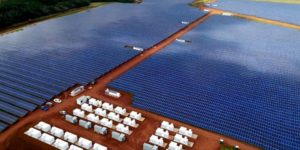
Tesla 13 Megawatt solar farm with 52 megawatt-hours of battery storage.
Energy from the sun will now be powering homes on the Hawaiian island of Kauai, even in the middle of the night. This is thanks to a recently-completed Tesla project that installed Tesla Powerpack batteries next to a 13 megawatt solar farm to help power the homes of the island’s inhabitants day or night.
The Kauai Island Utility Cooperative, which provides electricity to more than 20,000 islanders, initially contracted with SolarCity back in 2015 to construct a solar farm on their Kapaia facility. When Tesla merged with SolarCity in November it took over completion of the project.
The finished solar farm can generate 13 megawatts of power during the day, and also has 52 megawatt-hours of battery storage for supplying power at night. The Powerpack installation is designed to output around 13 megawatts of power during peak evening times.
The completion of the solar farm makes Kapaia the first utility-scale solar farm […]











Does it really make sense to have such disproportionate storage?
Awesome!
I don’t like Solar City and it is not perfect setup but at least the ball is moving toward replacing rediculous dinosaur technology.
This would be a big money saver once the cost comes down: after the initial cost of building the structure, only maintenance costs will be required, because the sun’s supplies of energy are free. Everyone would benefit in the end, with “almost” free energy. I certainly would benefit because, as a gardener, I must spend huge amounts for electricity for freezers to store our large quantities of vegetables and canning is too time consuming for old folks like myself and my wife.
“Disproportionate storage”?
You’re missing the wider context. It’s not as if there is not VAST land, resources, and money involved in storage of oil and gas, not to mention the enormous sums of money used to extract and ship it. Add to that environmental damage, leaks, spills and fires.
A 2016 WorldOil report out of london JUST FOR northwest Europe found that ‘oil companies in that region booked tankers to store as many as 9 MMbbl of crude in northwest Europe amid signs that space in on-land depots is filling up. Lack of on-land capacity to hold the oil is the most likely cause of the buildup’.
Beyond all this, it is, relatively speaking, a new industry and the rate of technological advancements–clearly indicated in this article–is outpacing anything in the wide field of energy production that has ever been seen before.